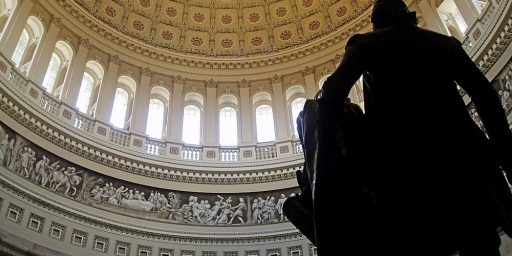Muslim Cartoon Rage Latest Example of Religious Virus
A new book argues that violence in the name of religion is a natural outgrowth of the viral nature of religion itself.
An ant climbs a blade of grass, over and over, seemingly without purpose, seeking neither nourishment nor home. It persists in its futile climb, explains Daniel C. Dennett at the opening of his new book, “Breaking the Spell: Religion as a Natural Phenomenon” (Viking), because its brain has been taken over by a parasite, a lancet fluke, which, over the course of evolution, has found this to be a particularly efficient way to get into the stomach of a grazing sheep or cow where it can flourish and reproduce. The ant is controlled by the worm, which, equally unconscious of purpose, maneuvers the ant into place.
Mr. Dennett, anticipating the outrage his comparison will make, suggests that this how religion works. People will sacrifice their interests, their health, their reason, their family, all in service to an idea “that has lodged in their brains.” That idea, he argues, is like a virus or a worm, and it inspires bizarre forms of behavior in order to propagate itself. Islam, he points out, means “submission,” and submission is what religious believers practice. In Mr. Dennett’s view, they do so despite all evidence, and in thrall to biological and social forces they barely comprehend.
Now that is iconoclasm — a wholehearted attempt to destroy a respected icon. “I believe that it is very important to break this spell,” Mr. Dennett writes, as he tries to undermine the claims and authority of religious belief. Attacks on religion, of course, have been a staple of Western secular society since the Enlightenment, though often carried out with far less finesse (and far less emphasis on biology) than Mr. Dennett does; he refers to “the widespread presumption by social scientists that religion is some kind of lunacy.”
Mr. Dennett understands, too, that iconoclasm, with its lack of deference, can also give offense. But not even he could have imagined the response to the now notorious Danish cartoons that have so offended Muslims around the world, leading to riots, death and destruction. It was as if the problem of religious belief in the modern world had been highlighted in garish colors. If Mr. Dennett’s attack is a premeditated spur to debate, the Muslim riots shock with their primordial force. Together, they leave us with a tough set of intertwining questions: Can religion — with its absolute and sweeping assertions — make any claim on a society whose doctrines require it to defer, in part, to all, even to blasphemers? Can religion be as dramatically shunted aside as Mr. Dennett desires? If not, what sort of accommodation is needed?
Mr. Dennett would like the coolness of reason to replace the commands of faith. The riots, though, show that at the very least, reason alone is insufficient. They are not just metaphorically iconoclastic in their challenge. They are literally iconoclastic: attempts to destroy any trace of forbidden images or inspire fear in any who might object. They are the latest manifestations of battles that once took place within the West, particularly during the eighth century, when iconoclasm got its name. At that time leaders of the Eastern Church, perhaps inspired by Islamic and Judaic prohibitions against images, objected to religious icons as a form of idolatry.
[…]
At a recent conference at Columbia University, “Religion and Liberalism,” organized by Andrew Delbanco and the American Studies Program, there were some fascinating attempts to try to imagine something other than iconoclasm in the relationship between secular politics and religion once eighth-century tactics are left behind. Speakers, including E. J. Dionne Jr., Mark Lilla, Alan Wolfe, Todd Gitlin, Mary Gordon, Susannah Heschel and Elisabeth Sifton, distanced themselves from the kind of attack on religion that Mr. Dennett proposes, while trying, too, to pry religion away from its contemporary association with conservative politics and fundamentalism. For some it seemed an attempt to “save” religion for liberalism, while still keeping a safe distance.
The issues, though, remain intractable and unrelenting. But it may be that the United States has already offered one kind of an answer, creating a society in which faith and reason continually cohabit in uneasy proximity, and iconoclasm is as commonplace as belief.
It is doubtless true that religion, like anything else that inspires intense passion, can lead to mass hysteria and even violence. A lot of blood has been shed in the name of nationalism, greed, and even romantic love. There are riots and murders over soccer games, for goodness sakes.
In the context of a rational society, however, these things tend to be moderated. As Rothstein notes in the last sentence of the excerpt, the United States is an example of a society that is both deeply religious and yet tolerant of iconoclasm. Christians in the United States routinely suffer what they perceive as insults to their creed, meeting them with reactions ranging from indifference to product boycotts to demanding the withholding of taxpayer funding. Rioting and mass murder, however, have long been considered beyond the pale.
________

See these cartoons in full size here.
Related entries below the fold.
-
Why He Published Those Cartoons
Nigeria Cartoon Riot Kills at Least 15
Cleric Offers Million Dollar Bounty for Murder of Cartoonist
Bama Riots Over Bear Bryant Cartoons
The Islamists’ War on the Internet
Pakistan Rioters Burn KFC, Pizza Hut, and McDonald’s
Cartoons as Emotional Torture and Intellectual Terrorism (Leopold Stotch)
Moderate Muslims Speak Out (Leopold Stotch)
Danish Muslim Cartoons: Blogger Hypocrisy?
Egypt Published Danish Cartoons During Ramadan
Danish Cartoons & Abu Ghraib Photos (Leopold Stotch)
Hypocrites? (Steve Verdon)
Danish Muslim Cartoons: What Would Mohammad Do?
Iranian Paper Launches Holocaust Cartoon Competition
Danish Muslim Cartoon Protests Kill Six
Dutch Muslim Cartoon: Anne Frank and Hitler in Bed
Danish Muslim Cartoon Controversy in Context
Danish Embassy in Syria Torched over Muslim Cartoons
Danish Muslim Cartoons ‘Offensive,’ Says U.S. Government
Muslim Day of Anger to Respond to Cartoons
French Editor Fired Over Muhammad Drawings
French and German Papers Republish Danish Cartoons
Danish Newspaper Apologizes for Muslim Cartoons





What is the definition of “deeply religious”? There is incredible disagreement as to the “religiousity” of US citizens. Even if one accepts a measure of 40%–which is around the norm in many self-reported studies that ask about church attendance–then the notion of the country as being “deeply religious” is suspect.
Political scientists who have looked historically at the data argue that there is a significant and discernable trend of lower attendance at church.
I would tend to agree with the hegelian sentiments of someone like Fukayama that the role of religion is undoubtedly going to be minimized in the face of science and rationalism.
Consider: The United States has contributed two of the worlds fastest growing religions to mankind, Mormanism and Scientology. Apparantly the long established historical religions do not meet the needs that many people have to believe in something ridiculous.
A great explanation of the foundation of Mormanism is given by Mark Twain in ‘Roughing It’. His conclusion, tongue in cheek, is to wonder how he could ever doubt the veracity of so many people who claim witness to seeing the golden tablets upon which the Book of Morman was delivered to Joseph Smith before the Angel Moroni took them back, never to be seen again by human eyes.
And while we do not yet have a modern version of Samual Clemons to explain Scientology to us can it be long before someone solves the puzzle as to why a growing numbr of our fellow human beings willingly believe in a faith founded on science fiction fantasy?
There will always be nutballs who find solace in silly mythical stories–but I think that it is a hopeful sign that the countries with the most robust economies and democratic political systems are seeing the role of religion deminish.
While the United States may be less advanced in this regard than folks in the nordic countries or Japan, the long-term trend is the deminishment of religion. It may take a while, but the pattern of historical change seems pretty resillient.
Ken: Well, there’s always South Park.
James, that south park episode is great. Thanks for the link.
While I’m no longer religious myself–I even gave a Carmelite seminary a whack, years ago–I have seen far too many people who receive a real benefit from their religious beliefs to simply mock them or their religions.
That isn’t to say, though, that religions are without flaw as obviously they all have them, whether at their origins or in their intepretations or in their practices. It’s not my business how religions sort out their internal problems. What is my business is where they intersect with my life.
Tolerance, accommodation, even begruding mutual acceptance can all help lessen the frictions that appear at the interface between religious and secular life, but those are all two-way streets. It’s not tolerance or accommodation if I have to follow your religion’s laws, no matter how firmly you believe them to be unique and faultless. You have to grant me the same respect toward my beliefs, whatever they are, within reason.
And while we do not yet have a modern version of H.P.Lovecraft to explain Liberal socialism to us can it be long before someone solves the puzzle as to why a growing number of our fellow human beings believes in a faith founded on science fiction fantasy?
Neal Stephenson made the argument that religion is viral in Snow Crash. But I never really believed it until recently.